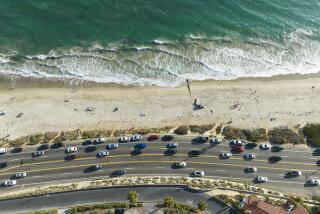Dedicated Surfers Ignore Sewage Spill
Despite a finding that waters off Seal Beach were contaminated with raw sewage at up to 15 times the allowable state limits, surfers attracted by good waves rode the swells Wednesday and kept lifeguards busy trying to enforce a temporary beach closure.
“They’ll walk right past the (beach closure) signs,” senior beach supervisor Steve Cushman said. “The waves are good, and they don’t care what it’s like out there.”
A one-mile stretch of strand in Seal Beach has remained closed since Saturday, when a million gallons of raw sewage flowed from a broken pipeline in Fullerton down the San Gabriel River to the ocean, creating a potential health hazard.
Water samples taken at Seal Beach on Monday showed concentrations of human waste bacteria ranging from nine to 15 times the allowable state standard of 1,000 per 100 milliliters of water, Orange County health officials said Wednesday.
Surfers who come in contact with the bacteria-laden waters risk catching hepatitis or contracting a skin rash, depending on their length of exposure and the bacterial concentration, said Steven Wong, assistant director for the county’s environmental health division, the agency that performed the testing.
New water samples were taken Wednesday and more will be gathered again today and Friday, Wong said, adding that the beach cannot be reopened until two samples have tested below the state limit.
“We anticipate the beach will remain closed, probably until Friday,” Wong said.
Meanwhile, the red-and-white signs--which read “Warning. Keep Out. Contaminated Water. By order of the Health Officer, County of Orange”--remain staked along the water’s edge. But many determined surfers, such as Mike Spencer of Huntington Beach, simply ignore them.
“I read the signs, but the waves were breaking pretty nice over there, so I thought I’d take the risk,” said the 17-year-old as he emerged from the surf. “I’ll just go home and take a shower.”
Cushman estimated that 200 people a day like Spencer have been asked to leave the water, either ordered out over land-based public address systems or, in stubborn cases, approached by Long Beach lifeguards in a powerboat and told to hit the sand.
Until the waters are declared safe and the beach is reopened, it appeared likely that lifeguards will continue to cajole surfers to come from the water. But they understand how tempting the current high waves are to the surfers.
“It’s kind of a shame because it’s about the best surf we’ve had for a couple of months,” said Seal Beach lifeguard Tom Tarpley as he watched from the river jetty rocks while a red-hulled powerboat approached several surfers.
When two of the disappointed wave-riders emerged from the waves, Tarpley suggested that they head farther south. “Huntington (Beach) is wide open, guys,” he told them.
Don Owen, 17, and Scott McManus, 15, finally left the water after the talking-to they got from the lifeguards in the boat. The two Lakewood teen-agers said they had taken the day off from school because the waves were good.
“We’ve been in for six hours--if something’s going to happen to us, it’ll happen to us,” said Don, adding that he had surfed before in an oil slick in Mexico. By comparison, he said, “you can’t (see) anything here.”
Mike Spencer and John Southerland, 17, also were ordered out of the waves by lifeguards. Neither was much troubled about the sewage spill.
“This is not as bad as the toxic stuff coming up in his backyard,” Mike joked, pointing at Southerland, who lives in a Westminster neighborhood where sludge oozing to the surface in many backyards has recently been determined to be toxic.
Surfing among sewage “doesn’t worry me at all,” Southerland said.
The spill’s cause remains under investigation by the County Sanitation Districts of Orange County, said the agency’s general counsel, Thomas Woodruff.
Woodruff said the district should know by next week how the sewage pipeline in a Unocal oil field in Fullerton was ruptured, leading to what county environmental health director Robert Merryman called one of the largest spills in the last six years.
In January, 1980, a 9-million-gallon spill from a Capistrano Beach treatment plant closed Salt Creek, Doheny and Capistrano beaches for two months, Merryman said. A March, 1981, spill near the Balboa Bay Club dumped 2 million gallons of sewage into Newport Bay, closing the bay for about four days, Sanitation Districts’ spokeswoman Corinne Clawson said.
More to Read
Sign up for Essential California
The most important California stories and recommendations in your inbox every morning.
You may occasionally receive promotional content from the Los Angeles Times.










